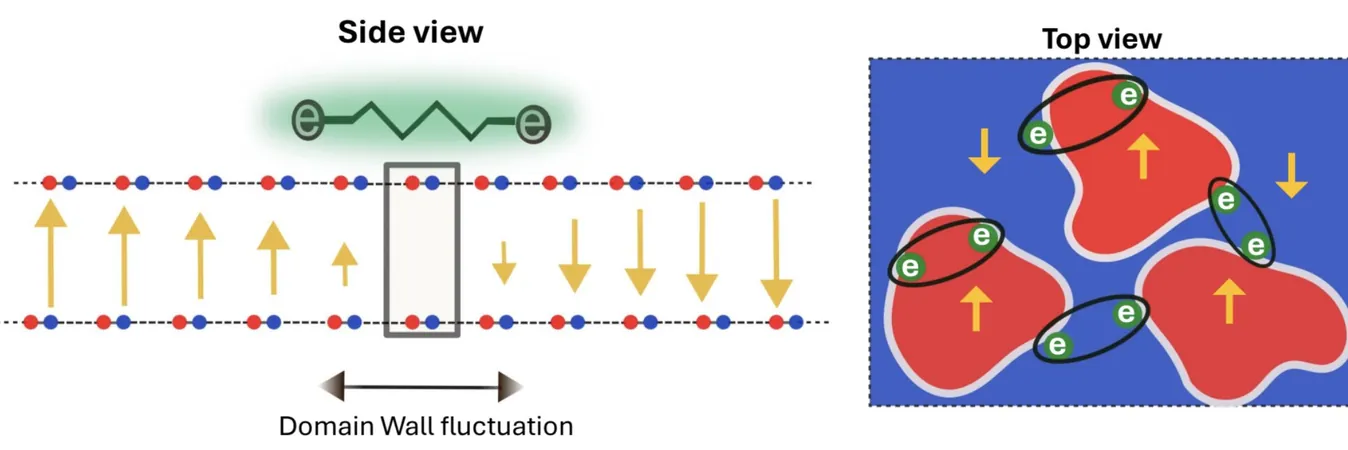
Groundbreaking Discovery: Domain Wall Fluctuations in 2D Materials Unveil a Surprising Superconductivity Mechanism!
2025-01-09
Author: Ming
Introduction
In a remarkable scientific breakthrough, researchers Gaurav Chaudhary from the University of Cambridge and Ivar Martin from Argonne National Laboratory have explored the exotic world of two-dimensional (2D) van der Waals materials. These materials, celebrated for their unique properties and composed of atomically thin layers bound by weak van der Waals forces, are increasingly recognized for their potential in uncovering rare physical phenomena.
The Study
Their recent study, published in *Physical Review Letters*, highlights a novel interplay between ferroelectric domain walls and electron interactions in specific 2D materials lacking an inversion center. This structural characteristic is vital for understanding the fascinating phenomenon known as “sliding ferroelectricity,” observed in several few-layer van der Waals materials like boron nitride and transition metal dichalcogenides (TMDs).
Sliding Ferroelectricity
Chaudhary and Martin elaborated on the concept of sliding ferroelectricity, which reveals that even metallic materials can exhibit built-in electric polarization due to their layered stacking configurations. The researchers found that applying moderate external electric fields can induce substantial changes in these configurations, allowing for significant control over polarization direction.
Implications of the Discovery
The implications of this discovery extend beyond mere academic interest—scientists and engineers alike are eager to explore practical applications of this effect. "Just like in ferromagnets, domain wall movements can provide an energetically efficient method to reverse polarization, paving the way for innovative electronic devices," the researchers stated.
Enhanced Superconductivity
Interestingly, during their investigation into sliding ferroelectricity, they observed tantalizing hints of enhanced superconductivity in the material MoTe2. They found that the superconducting transition temperature (Tc) dramatically increased during transitions involving ferroelectric domain wall reversals. This enhancement, however, appeared transient and occurred within the hysteresis loop leading to the discovery that the domain walls are conducive to the necessary electron pairing interactions essential for superconductivity.
Unique Environment near Domain Walls
The researchers noted that the region around the domain wall presents a unique environment where electron density directly couples to polarization, creating a potential drop across the layers of the material. This finding challenges the conventional notion that the absence of polarization would result in negligible coupling between itinerant electrons.
Reevaluation of Superconductivity Mechanisms
Conventional superconductivity is largely attributed to phonon (lattice vibration) interactions; however, Chaudhary and Martin suggest that in these layered materials, strong electron-electron interactions are also at play, crafting a new conceptual framework for understanding superconductivity.
Future Directions
This pioneering study opens doors for further exploration into the emergence of superconductivity in 2D TMDs and other bilayer van der Waals systems. The researchers plan to deepen their investigation, aiming to validate their theoretical predictions and aspire to develop highly controllable superconducting devices capable of toggling superconductivity on and off through manipulation of ferroelectric ordering.
Conclusion
Looking ahead, Chaudhary and Martin envision the systematic design of new superconductors by layering polar materials, along with the possibility of discovering similar mechanisms within moiré systems where domain walls form an organized network. This groundbreaking research not only adds to the growing body of knowledge about 2D materials but also holds the promise of paving the way for the next generation of superconducting technologies! Keep an eye on this field—exciting advancements are on the horizon!
 Brasil (PT)
Brasil (PT)
 Canada (EN)
Canada (EN)
 Chile (ES)
Chile (ES)
 Česko (CS)
Česko (CS)
 대한민국 (KO)
대한민국 (KO)
 España (ES)
España (ES)
 France (FR)
France (FR)
 Hong Kong (EN)
Hong Kong (EN)
 Italia (IT)
Italia (IT)
 日本 (JA)
日本 (JA)
 Magyarország (HU)
Magyarország (HU)
 Norge (NO)
Norge (NO)
 Polska (PL)
Polska (PL)
 Schweiz (DE)
Schweiz (DE)
 Singapore (EN)
Singapore (EN)
 Sverige (SV)
Sverige (SV)
 Suomi (FI)
Suomi (FI)
 Türkiye (TR)
Türkiye (TR)
 الإمارات العربية المتحدة (AR)
الإمارات العربية المتحدة (AR)